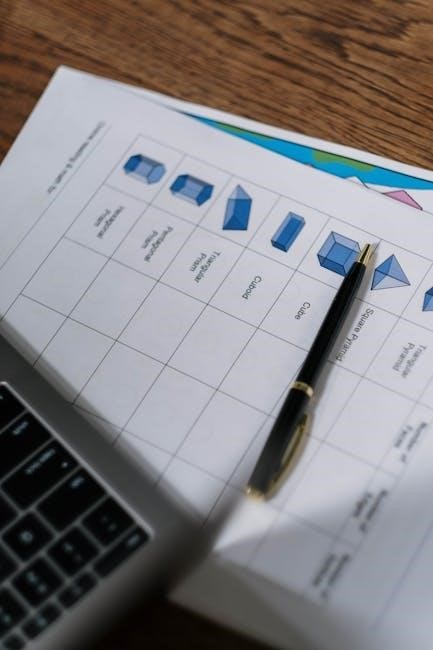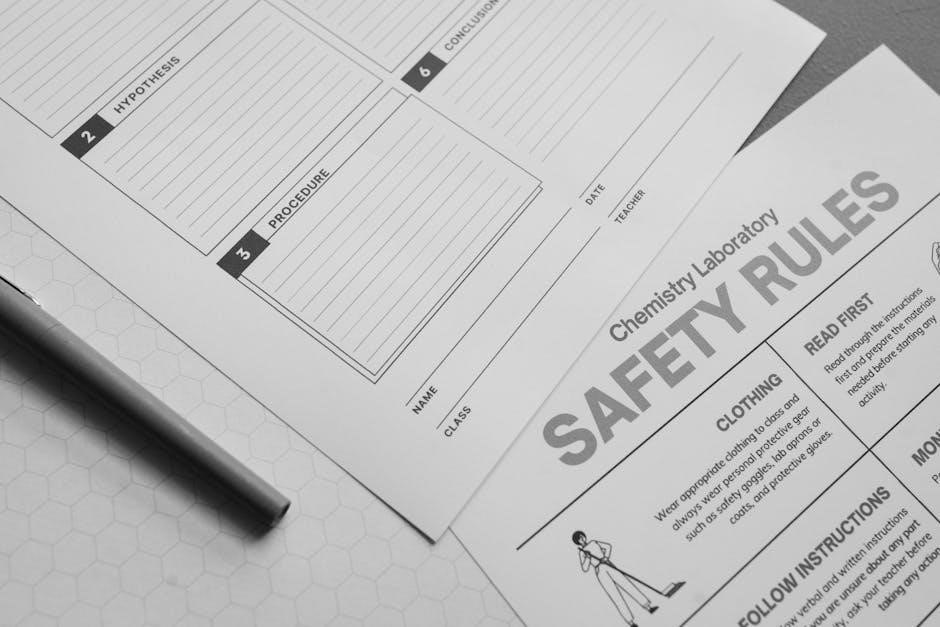Mastering decimal subtraction is a foundational skill in mathematics, essential for solving real-world problems. Worksheets simplify learning by providing structured practice, ensuring accuracy and confidence in calculations.
Importance of Mastering Decimal Subtraction
Mastering decimal subtraction is crucial for building a strong foundation in mathematics. It enhances problem-solving skills, particularly in real-world scenarios like handling money, measuring ingredients, or calculating distances. Accurate decimal subtraction is essential for balancing budgets, understanding price differences, and performing scientific measurements. Proficiency in this skill boosts confidence and prepares students for more complex mathematical operations. Regular practice using worksheets helps reinforce these concepts, ensuring precision and fluency. By mastering decimal subtraction, students develop a solid understanding of place value and numerical relationships, which are vital for advanced math topics.
Common Challenges in Subtracting Decimals

Subtracting decimals can present several challenges, particularly for beginners. One common issue is misaligning decimal points, leading to incorrect results. Students often struggle with borrowing across zeros, especially when dealing with multi-digit decimals. For instance, subtracting 0.03 from 0.05 requires careful borrowing to avoid errors. Another challenge is maintaining focus on place value, ensuring that tenths, hundredths, and thousandths are correctly managed. Additionally, word problems involving decimals can confuse students if they misinterpret the context or fail to apply the correct subtraction method. Regular practice with structured worksheets helps overcome these challenges by reinforcing proper techniques and building confidence. Consistent review and hands-on exercises are key to mastering decimal subtraction skills.

Key Concepts in Subtracting Decimals
Mastering decimal subtraction involves aligning decimal points, borrowing across zeros, and understanding place value. Using tools like base ten blocks and number lines enhances comprehension and accuracy.
Aligning Decimal Points for Accurate Subtraction
Aligning decimal points is crucial for accurate subtraction. When numbers are written in column form, ensure the decimal points line up vertically. If one number has no decimal, place a decimal point to the right. This prevents errors in place value. For example, subtracting 4.5 from 8.2 requires aligning the decimals:
- 8.2
- -4.5
- ______
- 3.7
This method ensures each digit is subtracted correctly, maintaining accuracy throughout the calculation. Worksheets often highlight this step to reinforce its importance in decimal operations.
Understanding Borrowing in Decimal Subtraction
Borrowing in decimal subtraction is similar to borrowing in whole numbers but requires careful attention to place value. When subtracting decimals, if the digit in the smaller place value is larger than the digit in the larger place value, borrowing is necessary. For example, in 4.9 ౼ 2.7, borrowing occurs when subtracting the tenths place (9 ౼ 7). Borrowing involves taking 1 from the whole number, converting it to tenths, and adding it to the smaller digit. This process ensures accurate calculations. Worksheets often include exercises that focus on borrowing across decimal points, helping students master this essential skill for precise results in decimal operations. Regular practice builds confidence and fluency in handling multi-digit decimal subtractions.

Strategies for Subtracting Decimals
Effective strategies for subtracting decimals include using base ten block models, number lines, and column methods. These approaches help students visualize and align decimal points accurately.
Using Base Ten Block Models
Base ten block models provide a hands-on approach to understanding decimal subtraction. These models represent units, tens, and hundredths, allowing students to visually subtract decimals by moving blocks between mats. By aligning the blocks according to their place value, learners can easily see how borrowing works across decimal points. This method builds conceptual understanding and reduces errors, making it an excellent tool for introducing decimal subtraction. Worksheets often accompany these models, reinforcing the connection between physical manipulation and written calculations. This strategy is particularly effective for visual and kinesthetic learners, helping them grasp the abstract concept of decimal subtraction in a tangible way.

Subtracting Decimals with Number Lines
Subtracting decimals with number lines involves marking both numbers on a line and measuring the distance between them. Start by aligning the decimals accurately. For example, to subtract 3.5 from 5.2, place both numbers on the line. The interval from 3.5 to 5.2 represents the difference. This visual method helps in understanding the subtraction process by showing the actual distance between the numbers, which corresponds to the result of the subtraction. Number lines are particularly useful for visual learners, as they provide a clear representation of how decimals relate to each other and how borrowing works in decimal subtraction. This approach simplifies the concept and makes it more accessible for learners to grasp and apply to various problems.
Practical Applications of Decimal Subtraction
Decimal subtraction is essential for daily tasks like calculating change, measuring ingredients, and budgeting. Worksheets help students apply these skills to real-life scenarios effectively.
Solving Word Problems Involving Decimals
Solving word problems involving decimals enhances real-world application of subtraction skills. For instance, calculating change from a purchase or measuring ingredients for a recipe requires precise decimal subtraction. Worksheets often include scenarios like determining remaining balances or comparing quantities. For example, if Paul buys a book for $6.89 with a $10 bill, the change due is $3.11. Similarly, Jennifer using 0.75kg of flour from 1.2kg leaves her with 0.45kg. These problems teach students to interpret and apply decimal subtraction in practical contexts, improving their ability to solve everyday mathematical challenges effectively. Such exercises boost problem-solving and critical thinking abilities, making math relevant and engaging.
Real-World Scenarios for Decimal Subtraction
Decimal subtraction is widely applied in everyday situations, such as calculating change, measuring ingredients, or comparing quantities. For example, when shopping, subtracting the purchase amount from the total cash paid gives the change. In cooking, subtracting used ingredients from the initial amount helps track remaining supplies. Additionally, in budgeting, subtracting expenses from income aids in financial planning. These scenarios highlight the practical importance of mastering decimal subtraction, as it enables individuals to handle monetary transactions, measure accurately, and make informed decisions. Worksheets featuring real-world problems help students connect mathematical concepts to daily life, fostering practical numeracy skills essential for independence and problem-solving.

Worksheets and Resources for Practice
Explore free PDF worksheets and interactive tools designed to enhance decimal subtraction skills through structured practice and real-world applications, ensuring comprehensive understanding and mastery of the concept.
Free PDF Worksheets for Decimal Subtraction
Free PDF worksheets provide an excellent way to practice decimal subtraction. These resources, designed for grades 5 and below, include a variety of exercises such as column subtraction, word problems, and number line activities. Many websites like K5 Learning and Brighterly offer comprehensive sets of worksheets that cater to different skill levels. Each worksheet focuses on specific aspects of decimal subtraction, such as aligning decimal points, borrowing, and applying concepts to real-world scenarios. They are structured to gradually increase in difficulty, allowing students to build confidence and proficiency. With clear instructions and answer keys, these worksheets are ideal for both classroom use and independent practice at home.
Interactive Tools for Practicing Decimal Subtraction
Interactive tools like online games, simulations, and digital worksheets make practicing decimal subtraction engaging and effective. Websites such as Corbettmaths and K5 Learning offer interactive resources that provide real-time feedback, helping students identify and correct mistakes instantly. These tools often include visual aids, such as number lines and base ten block models, to enhance understanding. Some platforms incorporate gamification, turning subtraction practice into competitions or puzzles to motivate learners. Additionally, interactive whiteboard activities allow teachers to demonstrate techniques dynamically, while students can participate actively. These tools are particularly useful for visual and kinesthetic learners, offering a hands-on approach to mastering decimal subtraction skills. They are also accessible on various devices, making practice convenient and flexible for students of all ages.

Assessment and Progress Tracking
Regularly assessing student progress with answer keys and solutions ensures accurate feedback. Tracking performance helps identify strengths and areas needing improvement in decimal subtraction skills.
Answer Keys and Solutions for Worksheets
Answer keys and solutions are essential for assessing student understanding of decimal subtraction. They provide clear, step-by-step explanations for each problem, ensuring accuracy and clarity. By comparing their work with the solutions, students can identify mistakes and improve their skills. Many worksheets include detailed answer keys, such as those for problems involving money, weight, or measurement. For example, in the problem where Paul buys a book for $6.89 and pays with a $10 note, the solution shows how to subtract decimals to find the change ($3.11). Similarly, Jennifer’s flour problem demonstrates subtracting 0.75kg from 1.2kg, resulting in 0.45kg. These solutions help students grasp the practical application of decimal subtraction in real-life scenarios. Educators can use these resources to track progress and provide targeted feedback, fostering a deeper understanding of the concept. Regular practice with answer keys enhances problem-solving abilities and builds confidence in handling decimal operations effectively.
Evaluating Student Understanding
Evaluating student understanding of decimal subtraction involves assessing their ability to apply concepts accurately. Teachers use worksheets, quizzes, and classwork to gauge mastery. Regular assessments help identify gaps in knowledge. Constructive feedback is provided to guide improvement. Students’ work is reviewed for proper alignment of decimals, borrowing techniques, and correct answers. timed quizzes and tests measure fluency and accuracy. Digital tools also track progress, offering insights into student performance; Evaluating understanding ensures learners are prepared for real-world applications and higher-level math. Consistent assessment helps refine teaching strategies, targeting areas where students struggle. This process fosters confidence and proficiency in handling decimals, a crucial skill for future academic success. By monitoring progress, educators ensure students achieve long-term comprehension and practical application of decimal subtraction concepts.
Mastering decimal subtraction is crucial for real-world applications. Worksheets provide structured practice, ensuring accuracy and confidence in handling decimals, making them an invaluable learning resource for students.
Summarizing the Benefits of Decimal Subtraction Worksheets
Decimal subtraction worksheets offer numerous benefits, enhancing mathematical proficiency in a structured manner. They provide targeted practice, improving accuracy and speed. By presenting problems in various formats, including word problems, these worksheets develop critical thinking and real-world application skills. Visual aids like number lines and base ten models aid comprehension, making abstract concepts tangible. Regular use builds confidence, reducing anxiety often associated with decimal operations. Additionally, worksheets cater to different learning styles, ensuring each student grasps the material effectively. Their progressive difficulty fosters a smooth transition from basic to advanced subtraction, solidifying foundational math skills essential for future academic success.
